ВУЗ: Не указан
Категория: Не указан
Дисциплина: Не указана
Добавлен: 01.04.2021
Просмотров: 1549
Скачиваний: 7
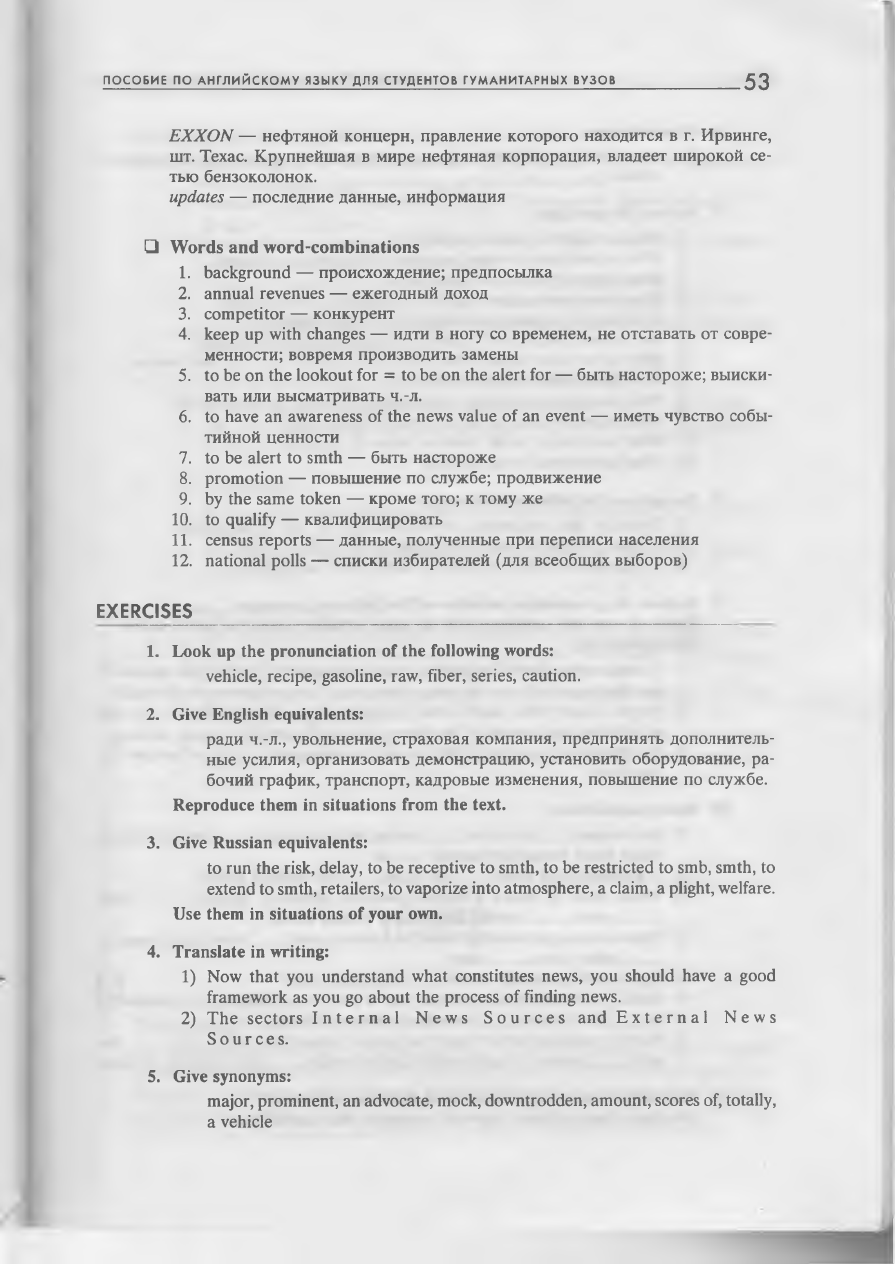
П О С О Б И Е П О А Н Г Л И Й С К О М У Я З Ы К У Д Л Я С Т У Д Е Н Т О В Г У М А Н И Т А Р Н Ы Х В У З О В
53
E X X O N
— нефтяной концерн, правление которого находится в г. Ирвинге,
шт. Техас. Крупнейшая в мире нефтяная корпорация, владеет широкой се
тью бензоколонок.
updates
— последние данные, информация
□ Words and word-combinations
1. background — происхождение; предпосылка
2. annual revenues — ежегодный доход
3. competitor — конкурент
4. keep up with changes — идти в ногу со временем, не отставать от совре
менности; вовремя производить замены
5. to be on the lookout for = to be on the alert for — быть настороже; выиски
вать или высматривать ч.-л.
6. to have an awareness of the news value of an event — иметь чувство собы
тийной ценности
7. to be alert to smth — быть настороже
8. promotion — повышение по службе; продвижение
9. by the same token — кроме того; к тому же
10. to qualify — квалифицировать
11. census reports — данные, полученные при переписи населения
12. national polls — списки избирателей (для всеобщих выборов)
EXERCISES
1. Look up the pronunciation of the following words:
vehicle, recipe, gasoline, raw, fiber, series, caution.
2. Give English equivalents:
ради ч.-л., увольнение, страховая компания, предпринять дополнитель
ные усилия, организовать демонстрацию, установить оборудование, ра
бочий график, транспорт, кадровые изменения, повышение по службе.
Reproduce them in situations from the text.
3. Give Russian equivalents:
to run the risk, delay, to be receptive to smth, to be restricted to smb, smth, to
extend to smth, retailers, to vaporize into atmosphere, a claim, a plight, welfare.
Use them in situations of your own.
4. Translate in writing:
1) Now that you understand what constitutes news, you should have a good
framework as you go about the process of finding news.
2) The sectors I n t e r n a l N e w s S o u r c e s and E x t e r n a l N e w s
S o u r c e s .
5. Give synonyms:
major, prominent, an advocate, mock, downtrodden, amount, scores of, totally,
a vehicle
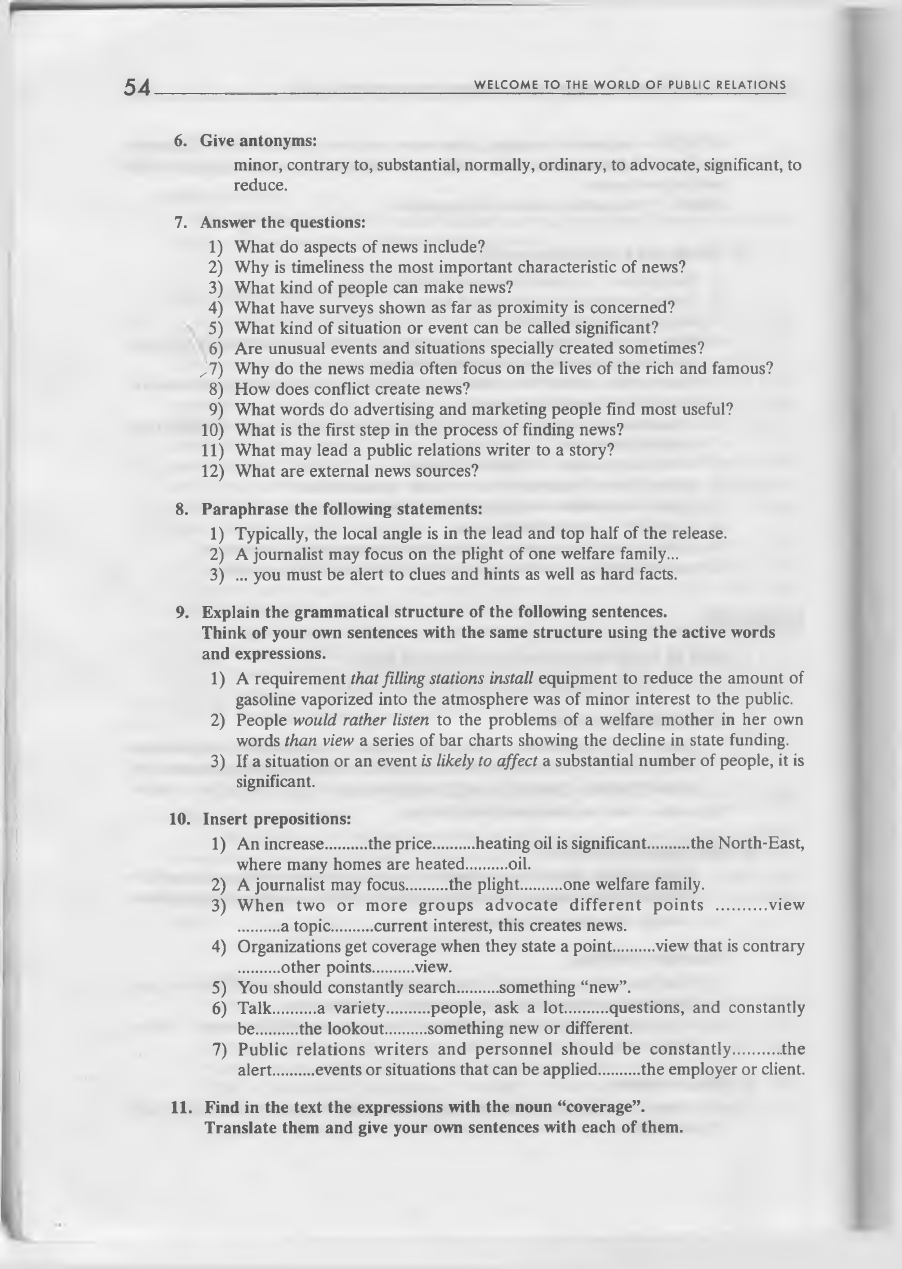
54
W E L C O M E T O T H E W O R L D O F P U B L I C R E L A T I O N S
6
. Give antonyms:
minor, contrary to, substantial, normally, ordinary, to advocate, significant, to
reduce.
7. Answer the questions:
1) What do aspects of news include?
2) Why is timeliness the most important characteristic of news?
3) What kind of people can make news?
4) What have surveys shown as far as proximity is concerned?
5) What kind of situation or event can be called significant?
6) Are unusual events and situations specially created sometimes?
J7)
Why do the news media often focus on the lives of the rich and famous?
8) How does conflict create news?
9) What words do advertising and marketing people find most useful?
10) What is the first step in the process of finding news?
11) What may lead a public relations writer to a story?
12) What are external news sources?
8
. Paraphrase the following statements:
1) Typically, the local angle is in the lead and top half of the release.
2) A journalist may focus on the plight of one welfare family...
3) ... you must be alert to clues and hints as well as hard facts.
9. Explain the grammatical structure of the following sentences.
Think of your own sentences with the same structure using the active words
and expressions.
1) A requirement
that filling stations install
equipment to reduce the amount of
gasoline vaporized into the atmosphere was of minor interest to the public.
2) People
would rather listen
to the problems of a welfare mother in her own
words
than view
a series of bar charts showing the decline in state funding.
3) If a situation or an event
is likely to affect
a substantial number of people, it is
significant.
10. Insert prepositions:
1) An increase......... the price......... heating oil is significant..........the North-East,
where many homes are heated......... oil.
2) A journalist may focus......... the plight..........one welfare family.
3) W hen two or m ore groups advocate d ifferen t p o ints ........... view
......... a topic..........current interest, this creates news.
4) Organizations get coverage when they state a point......... view that is contrary
......... other points..........view.
5) You should constantly search......... something “new”.
6) Talk..........a variety.......... people, ask a lot.......... questions, and constantly
be......... the lookout..........something new or different.
Public relations writers and personnel should be constantly.......... the
alert......... events or situations that can be applied......... the employer or client.
11. Find in the text the expressions with the noun “coverage”.
Translate them and give your own sentences with each of them.
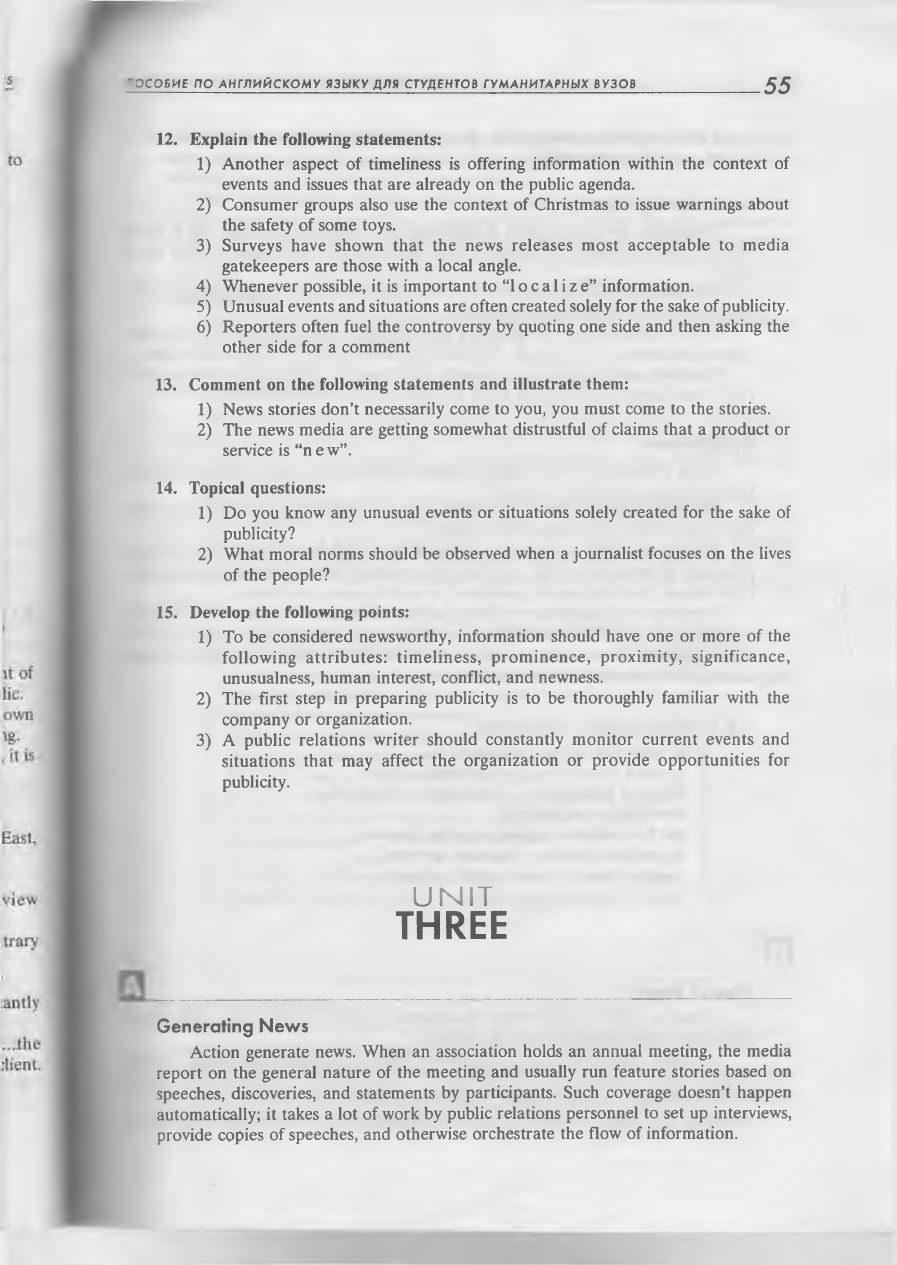
~ Э С О Б И Е П О А Н Г Л И Й С К О М У
Я З Ы К У
Д Л Я СТ УДЕНТ ОВ Г У МА Н И Т А Р Н ЫХ В У З О В
55
12.
Explain the following statements:
1) Another aspect of timeliness is offering information within the context of
events and issues that are already on the public agenda.
2) Consumer groups also use the context of Christmas to issue warnings about
the safety of some toys.
3) Surveys have shown that the news releases most acceptable to media
gatekeepers are those with a local angle.
4) Whenever possible, it is important to “1 о с a 1 i z e” information.
5) Unusual events and situations are often created solely for the sake of publicity.
6) Reporters often fuel the controversy by quoting one side and then asking the
other side for a comment
13. Comment on the following statements and illustrate them:
1) News stories don’t necessarily come to you, you must come to the stories.
2) The news media are getting somewhat distrustful of claims that a product or
service is “n e w”.
14. Topical questions:
1) Do you know any unusual events or situations solely created for the sake of
publicity?
2) What moral norms should be observed when a journalist focuses on the lives
of the people?
15. Develop the following points:
1) To be considered newsworthy, information should have one or more of the
following attributes: tim eliness, prom inence, proxim ity, significance,
unusualness, human interest, conflict, and newness.
2) The first step in preparing publicity is to be thoroughly familiar with the
company or organization.
3) A public relations writer should constantly monitor current events and
situations that may affect the organization or provide opportunities for
publicity.
U N I T
THREE
_________________________ ___________________________________________________________________ _________
Generating News
Action generate news. When an association holds an annual meeting, the media
report on the general nature of the meeting and usually run feature stories based on
speeches, discoveries, and statements by participants. Such coverage doesn’t happen
automatically; it takes a lot of work by public relations personnel to set up interviews,
provide copies of speeches, and otherwise orchestrate the flow of information.
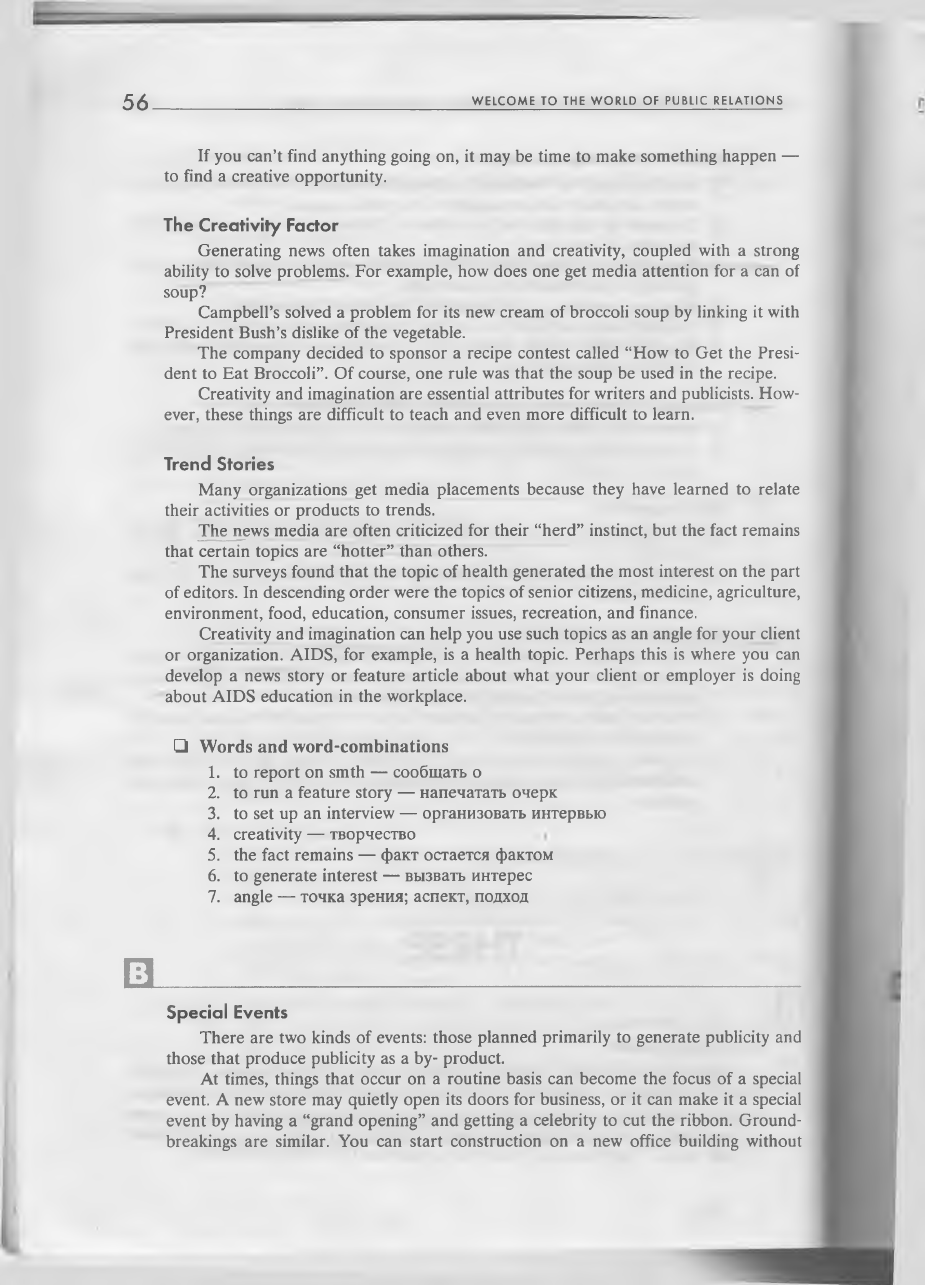
56
W E L C O M E T O T H E W O R L D O F P U B L I C R E L A T I O N S
If you can’t find anything going on, it may be time to make something happen —
to find a creative opportunity.
The Creativity Factor
Generating news often takes imagination and creativity, coupled with a strong
ability to solve problems. For example, how does one get media attention for a can of
soup?
Campbell’s solved a problem for its new cream of broccoli soup by linking it with
President Bush’s dislike of the vegetable.
The company decided to sponsor a recipe contest called “How to Get the Presi
dent to Eat Broccoli”. Of course, one rule was that the soup be used in the recipe.
Creativity and imagination are essential attributes for writers and publicists. How
ever, these things are difficult to teach and even more difficult to learn.
Trend Stories
Many organizations get media placements because they have learned to relate
their activities or products to trends.
The news media are often criticized for their “herd” instinct, but the fact remains
that certain topics are “hotter” than others.
The surveys found that the topic of health generated the most interest on the part
of editors. In descending order were the topics of senior citizens, medicine, agriculture,
environment, food, education, consumer issues, recreation, and finance.
Creativity and imagination can help you use such topics as an angle for your client
or organization. AIDS, for example, is a health topic. Perhaps this is where you can
develop a news story or feature article about what your client or employer is doing
about AIDS education in the workplace.
□ Words and word-combinations
1. to report on smth — сообщать о
2. to run a feature story — напечатать очерк
3. to set up an interview — организовать интервью
4. creativity — творчество
5. the fact remains — факт остается фактом
6. to generate interest — вызвать интерес
7. angle — точка зрения; аспект, подход
П
L J _____________ ______ ___ _____ ___________________________________________________________________________
Special Events
There are two kinds of events: those planned primarily to generate publicity and
those that produce publicity as a by- product.
At times, things that occur on a routine basis can become the focus of a special
event. A new store may quietly open its doors for business, or it can make it a special
event by having a “grand opening” and getting a celebrity to cut the ribbon. Ground-
breakings are similar. You can start construction on a new office building without
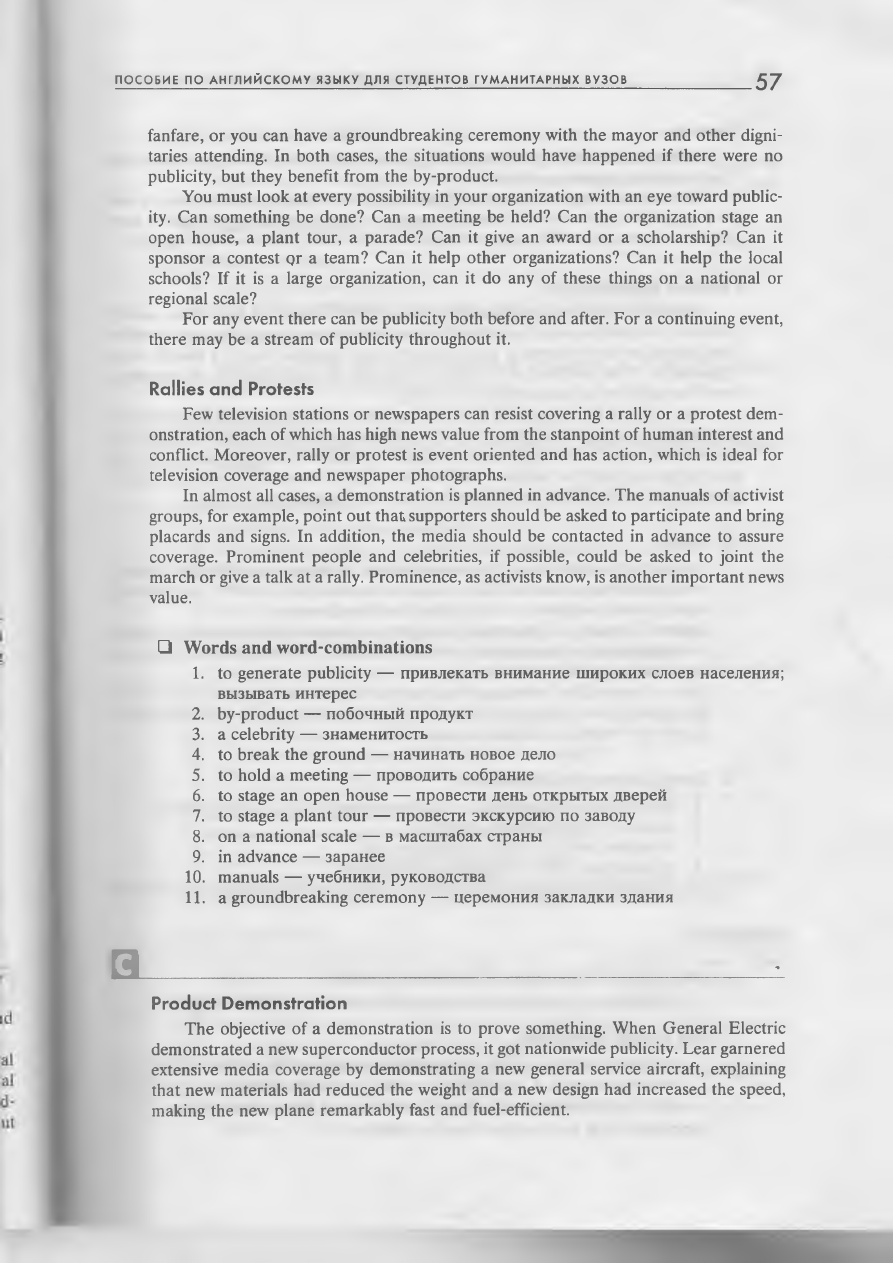
П О С О Б И Е П О А Н Г Л И Й С К О М У Я З Ы К У Д Л Я С Т У Д Е Н Т О В Г У М А Н И Т А Р Н Ы Х В У З О В
57
fanfare, or you can have a groundbreaking ceremony with the mayor and other digni
taries attending. In both cases, the situations would have happened if there were no
publicity, but they benefit from the by-product.
You must look at every possibility in your organization with an eye toward public
ity. Can something be done? Can a meeting be held? Can the organization stage an
open house, a plant tour, a parade? Can it give an award or a scholarship? Can it
sponsor a contest
Qr
a team? Can it help other organizations? Can it help the local
schools? If it is a large organization, can it do any of these things on a national or
regional scale?
For any event there can be publicity both before and after. For a continuing event,
there may be a stream of publicity throughout it.
Rallies and Protests
Few television stations or newspapers can resist covering a rally or a protest dem
onstration, each of which has high news value from the stanpoint of human interest and
conflict. Moreover, rally or protest is event oriented and has action, which is ideal for
television coverage and newspaper photographs.
In almost all cases, a demonstration is planned in advance. The manuals of activist
groups, for example, point out that supporters should be asked to participate and bring
placards and signs. In addition, the media should be contacted in advance to assure
coverage. Prominent people and celebrities, if possible, could be asked to joint the
march or give a talk at a rally. Prominence, as activists know, is another important news
value.
□ Words and word-combinations
1. to generate publicity — привлекать внимание широких слоев населения;
вызывать интерес
2. by-product — побочный продукт
3. a celebrity — знаменитость
4. to break the ground — начинать новое дело
5. to hold a meeting — проводить собрание
6. to stage an open house — провести день открытых дверей
7. to stage a plant tour — провести экскурсию по заводу
8. on a national scale — в масштабах страны
9. in advance — заранее
10. manuals — учебники, руководства
11. a groundbreaking ceremony — церемония закладки здания
а ___________________________________ •
Product Demonstration
The objective of a demonstration is to prove something. When General Electric
demonstrated a new superconductor process, it got nationwide publicity. Lear garnered
extensive media coverage by demonstrating a new general service aircraft, explaining
that new materials had reduced the weight and a new design had increased the speed,
making the new plane remarkably fast and fuel-efficient.